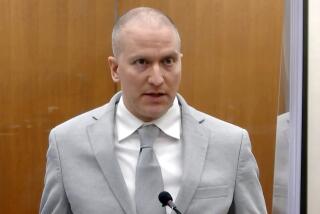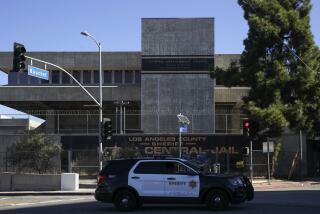Detainees Describe CIA Agent’s Slaying
- Share via
WASHINGTON — Captives from Afghanistan have told FBI agents that CIA officer Johnny “Mike” Spann became the first American to die in a clash in Afghanistan after he shot to death a prisoner who was attempting to attack him, possibly sparking the prison riot that claimed his life.
The events surrounding Spann’s death three years ago have never been fully explained by U.S. officials. Government accounts have said he was swarmed by angry Taliban soldiers at the prison and crushed or beaten to death, but his father has suggested that his son may have been shoved to his knees and shot execution-style.
No concrete details on the death emerged in the court case of John Walker Lindh, the so-called American Taliban from Marin County, who had been interrogated by Spann shortly before the CIA agent died. The Afghan prisoners said Lindh shouted out around the time of the prison uprising that he was “an American and spoke English,” in an attempt to escape harm from U.S. and anti-Taliban Northern Alliance forces.
The newly public FBI reports, released Tuesday along with several hundred pages of other documents obtained by the American Civil Liberties Union in a lawsuit against the U.S. government seeking information on the treatment of detainees, do not indicate whether the detainees’ accounts were considered believable by U.S. officials.
Four prisoners being held at the U.S. naval base at Guantanamo Bay, Cuba, were interviewed by the FBI. Their accounts describe Spann as wearing bluejeans, an AK-47 rifle slung over his back and a pistol on his hip, trying to interview Taliban captives -- including Lindh -- when he was attacked by a prisoner and shot him.
Spann, one captive told the FBI, “was jumped by an Arab or Pakistani male, but the armed man [Spann] shot the prisoner. People began running and chaos ensued.”
Another captive described the events of Nov. 25, 2001, in a prison courtyard near Mazar-i-Sharif somewhat differently. Taliban forces had been overcome by Northern Alliance troops at the fort, and Spann was accompanying the Northern Alliance.
“There was an explosion ... from a grenade,” the other detainee told the FBI. “The American male wearing jeans then ran away from the lines of prisoners. One of the prisoners ran after him. The American turned and fired his pistol, shooting the prisoner in the head. The guards above began firing into the courtyard.”
Spann’s death and Lindh’s capture unfolded as a national drama in the aftermath of the Sept. 11 attacks on the U.S., with Spann hailed as a hero and Lindh vilified as a traitor.
But because Lindh never went to trial -- instead pleading guilty to reduced charges in return for a 20-year sentence -- complete details of the deadly Sunday at Mazar-i-Sharif have never emerged.
Videotape broadcast by news organizations showed Spann trying to interview Lindh. The video stopped before the prison uprising began.
The FBI interviews with the detainees were conducted months later, after the prisoners were flown to Guantanamo Bay. In the first such account, the captives asserted that Spann shot a prisoner and that the shooting triggered the riot that led to Spann’s death.
Spann’s father, also named Johnny Spann, a Winfield, Ala., real estate executive, said Tuesday night that he had painstakingly searched for information on his 32-year-old son’s death but had never heard of his son shooting a prisoner.
“I don’t know that these FBI reports are right,” Spann said in a telephone interview. “And I’m not so sure the prisoners know what they’re saying.”
The elder Spann said he had traveled to Afghanistan and interviewed people who might have known his son.
He said he had been told that his son was standing with two physicians treating an injured prisoner when groups of other captives charged out of a prison building, firing guns.
He said his son emptied his AK-47, then began firing his pistol, but was overwhelmed by the detainees.
He said he did not know whether his son was killed in the exchange or taken hostage and slain later.
In their account, the prisoners described Spann and a second CIA operative, later identified as David Tyson, alternately as American soldiers and “Russians.” One detainee said Spann spoke their language “well” and that he “was talking to some of the prisoners” moments before the prison uprising.
None of the four said he actually saw Spann die. Some said they were wounded in the uprising, and only later noticed Spann’s body on the ground alongside fallen Taliban prisoners.
One captive said he saw Spann “running toward the [prison] building through some of the prisoners.” He said that “some of the prisoners jumped toward the man and others tripped the man when he was running.”
That captive said he was shot and lost consciousness. When he regained consciousness, he began crawling to safety toward the fortress basement.
He said he noticed Spann “lying on the ground near the entrance of the basement, tangled with a prisoner as if they had been fighting.” The captive added that he “assumed” that Spann was dead.
Another captive said Spann shot a prisoner in the head, then “ran in the direction of the [prison] building.” He said he saw “several prisoners run after the American and ramming him with their bodies.” But the captive also said he had been shot and “did not see what happened to the American.”
The captive said he slowly crawled toward the building, wounded in both legs and with his hands tied behind his back. Along the way, he said, he saw a man he thought was “the American, lying on the ground.”
The captive added: “He was lying next to an Uzbek, and both men were dead. The two men looked like they died fighting each other because their bodies were entangled.”
A third captive recalled hearing what he said was one of two American prisoners among the Taliban, presumably Lindh, who “shouted that he was an American and spoke English.” But the captive said no one would answer the American prisoner because “the guards would severely beat anyone who spoke.”
Nearly a year later, when Lindh pleaded guilty in federal court in Alexandria, Va., in October 2002, Spann’s father angrily urged the judge to give him a much longer sentence than 20 years, all but accusing Lindh of murdering his son.
But U.S. District Judge T.S. Ellis III stressed that the government had no evidence that Lindh had anything to do with Spann’s death. At that point, there was no hard evidence on exactly how Spann had died -- a mystery that continues.
The judge based his finding on a statement Lindh made in court that day. The accused stood and told the judge: “That’s correct, sir. I had no role in the death of Johnny ‘Mike’ Spann.”
More to Read
Sign up for Essential California
The most important California stories and recommendations in your inbox every morning.
You may occasionally receive promotional content from the Los Angeles Times.













